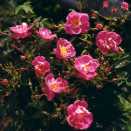A couple of comments on your rose issues.
I'm not surprised if you are having trouble with 'Playboy' and 'Betty Boop,' as they are not particularly tough.
I even know people here who have given up on 'Betty,' though' Playboy' seems easier.
And, speaking of 'Peace, ' I read somewhere several years ago that 'Peace' has been produced and reproduced
(cloned) so much for so many years that it has "weakened," which is why it has become more difficult to raise a
really good quality new 'Peace' in our short-season area.
As far as your problems with fried roses during the summer, there is one thing I was thinking you might want
to try.
When I was working for a nursery, I ordered hundreds of dormant bare root roses and had to pot them up ASAP
and try to give them the best chance of survival. One of the "tips" I got from one of the big rose companies was
to use the anti-transpirants 'Cloud Cover' or 'Wilt-Pruf' to keep the roses from losing moisture from their stems
and leaves.
A lot of times, these are used on wreaths or other holiday evergreens, to keep them looking fresh, but they work
well on live plants, too. You should be able to find them at a bigger nursery, or even someplace like Home
Depot, or "Home Dopey," as my son calls it. Wind seems to be even more drying than sun up here, and 'Cloud
Cover' would be worth trying on your wind-walloped roses, too.
I noticed a definite difference in how many roses successfully came out of dormancy after I started blasting
them with 'Cloud Cover.' You might want to try it after a good watering during the hot season, and see what
happens.
I've also heard that keeping the fertilizing to a bare minimum during the hottest part of the summer can help
in blast furnace areas. Give a good fertilizing about a month before the hottest weather, and then just water
during the worst heat.
As for your wildlife rambler, I would give 'William Baffin' a try --

it is the only rose I had to repeatedly prune back at the nursery. It shot out canes like crazy, and was covered
with blooms. I have heard it is hardy into zone 2. If you planted two or three together, you could have good
shelter for birds. It's technically a climber, but you could have a nice big heap of branches if you didn't train it
all straight up. There isn't much fragrance, but it's an extremely hardy repeat bloomer.


